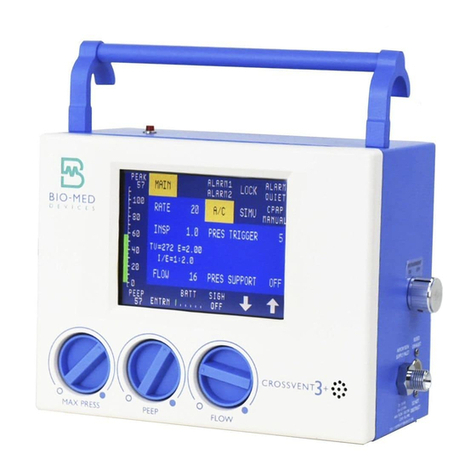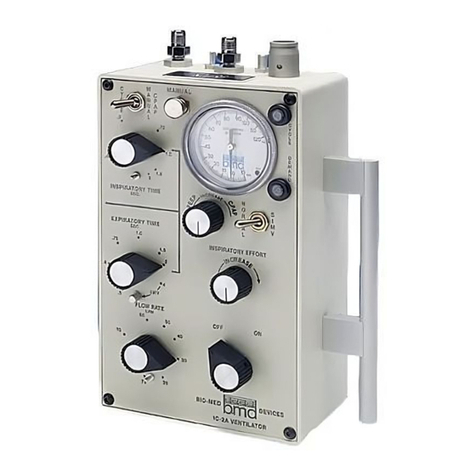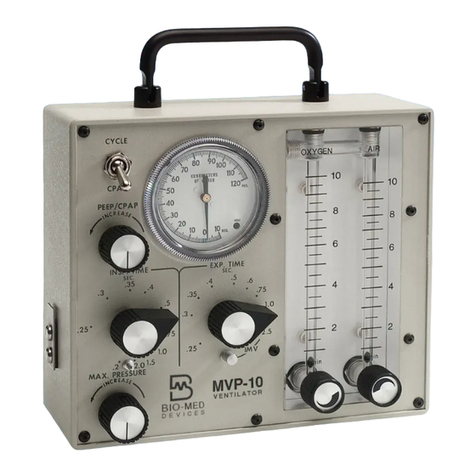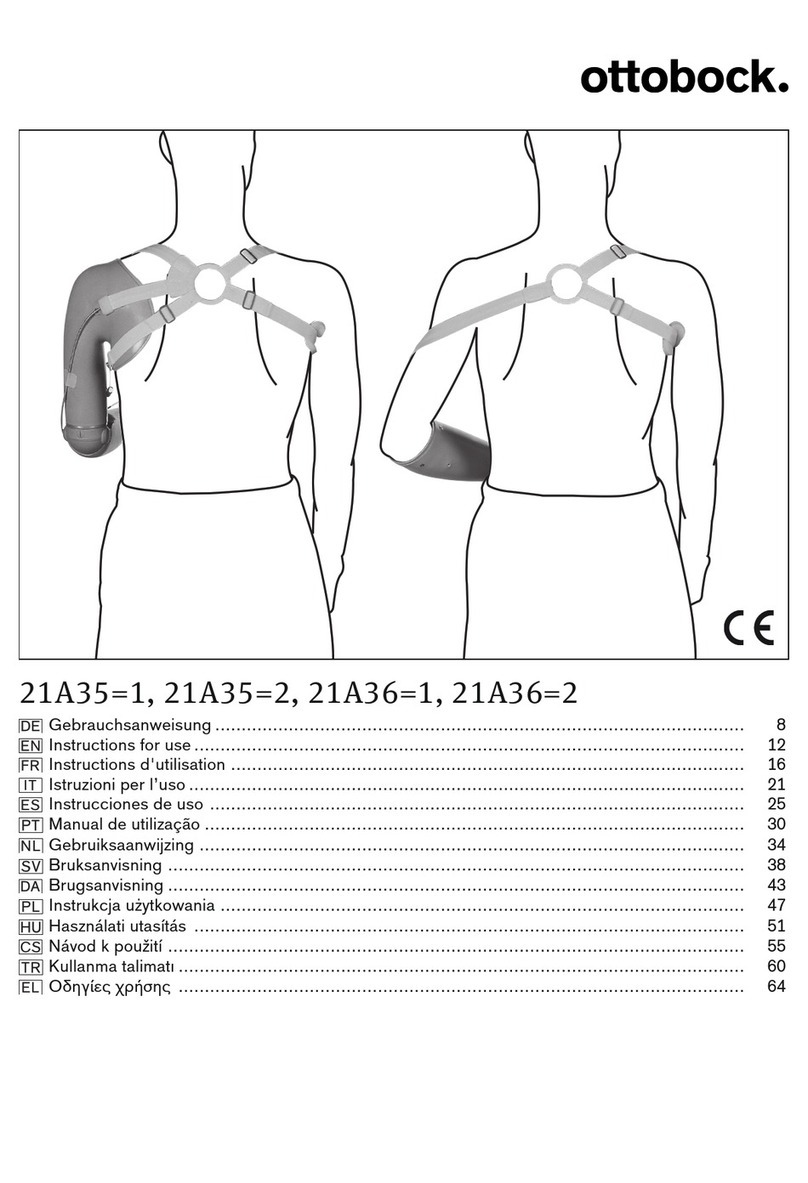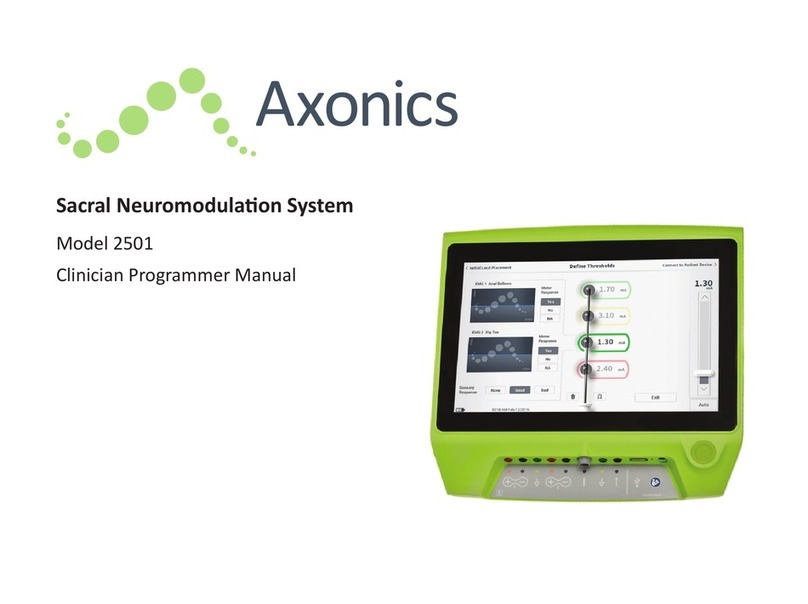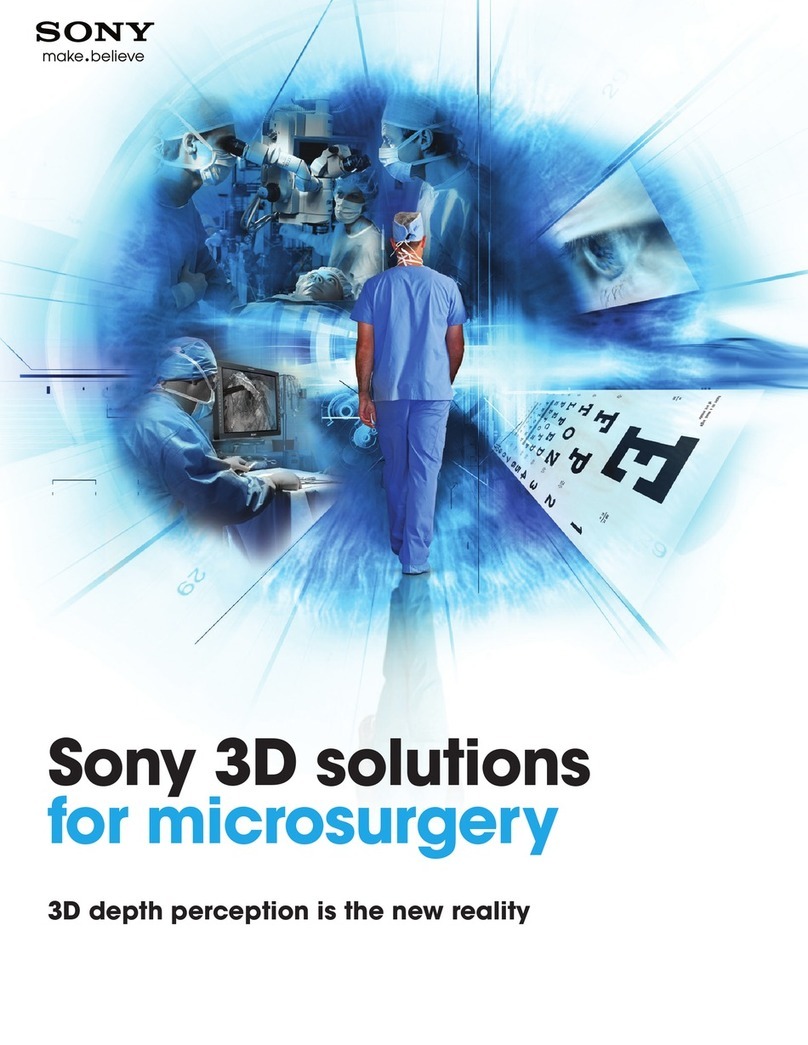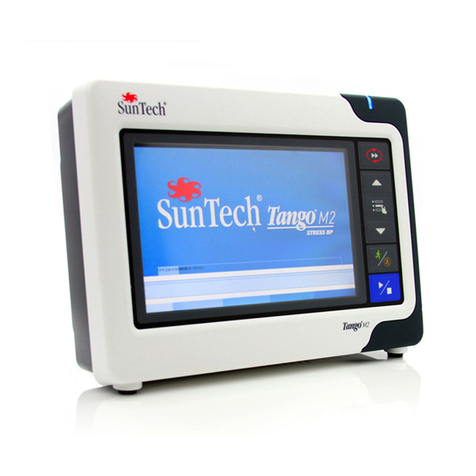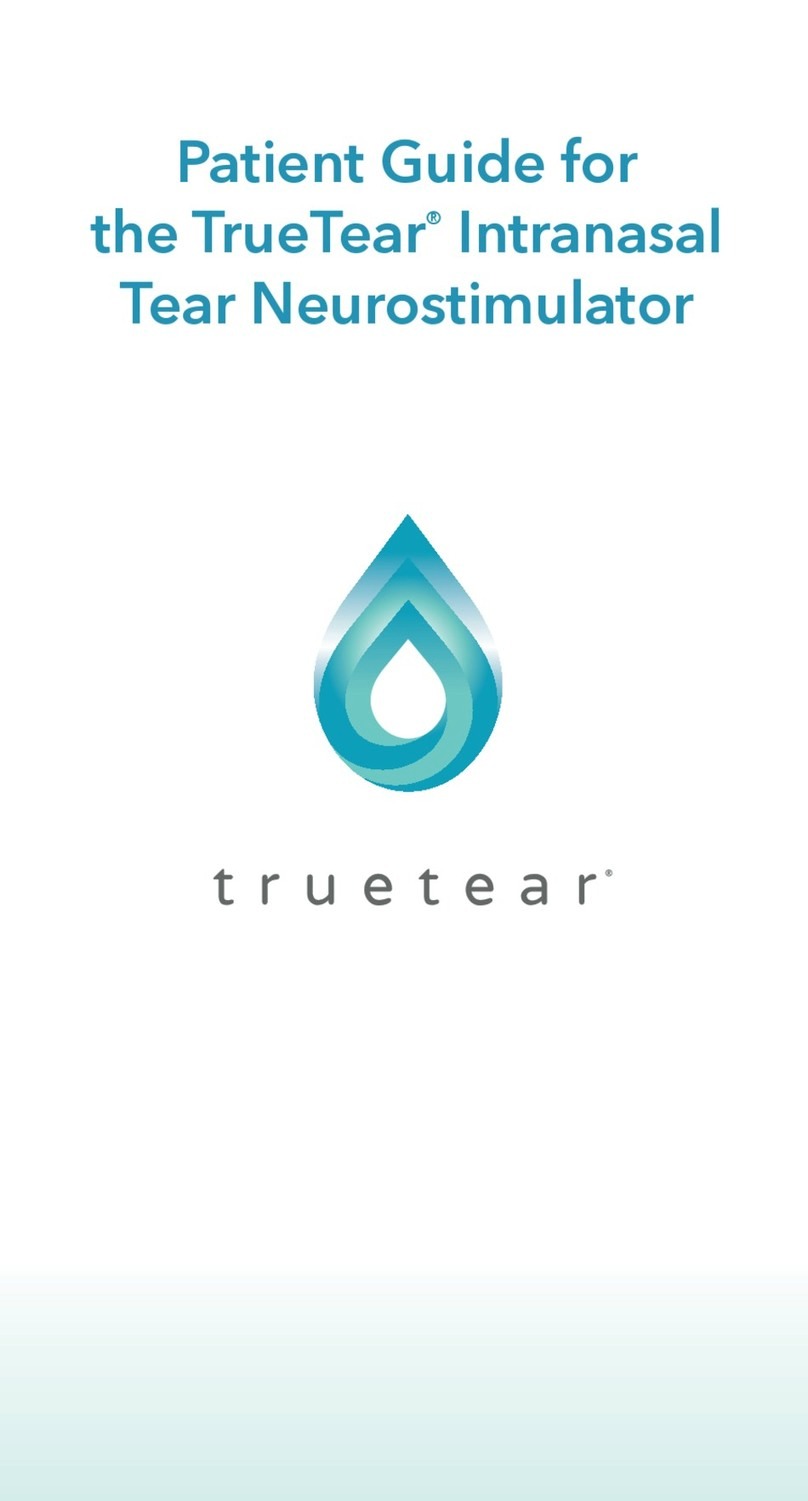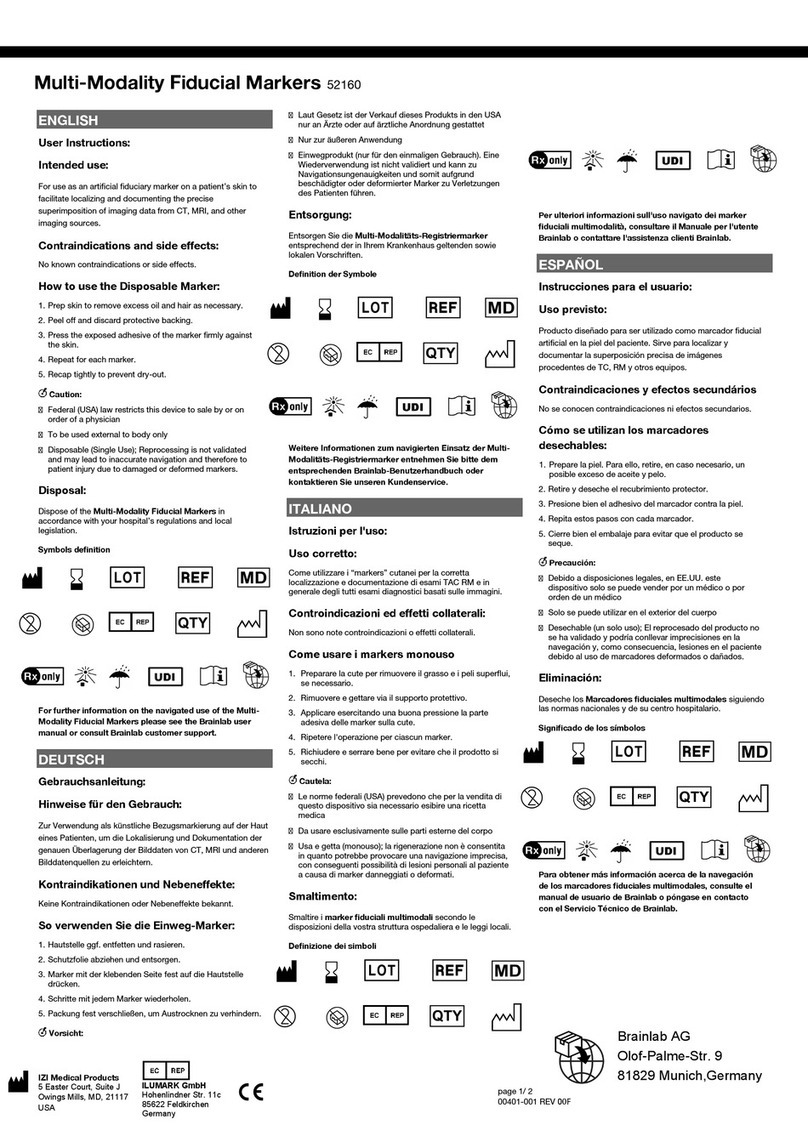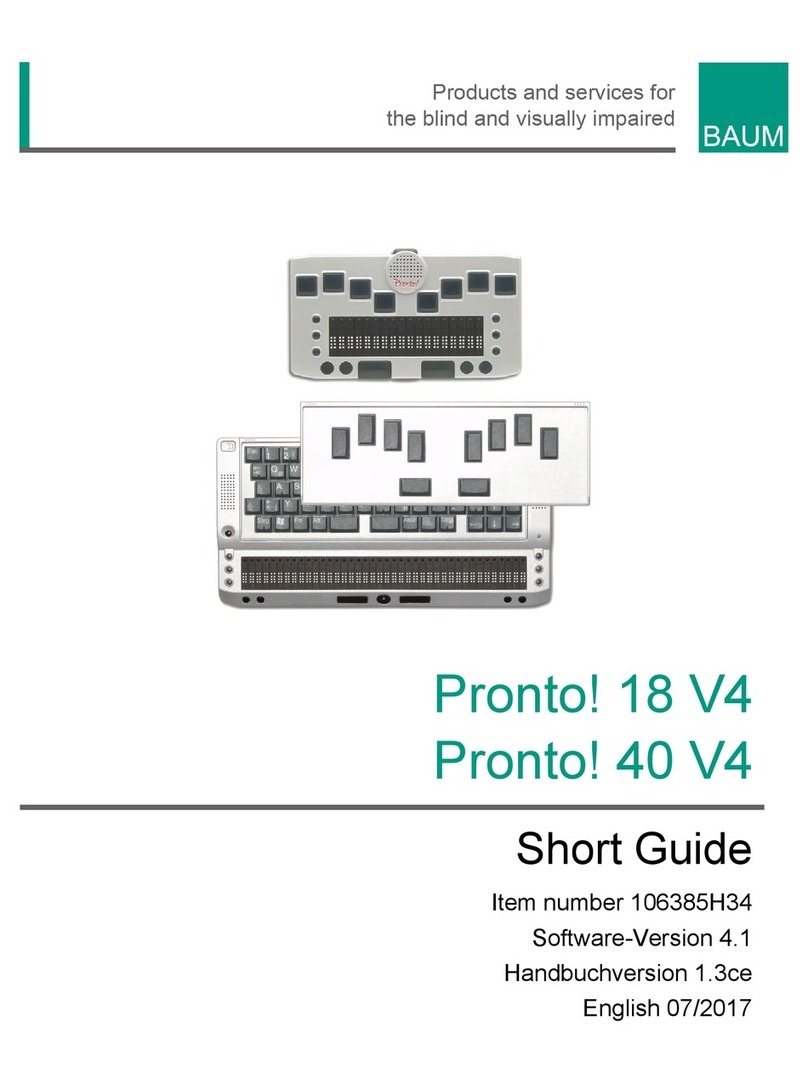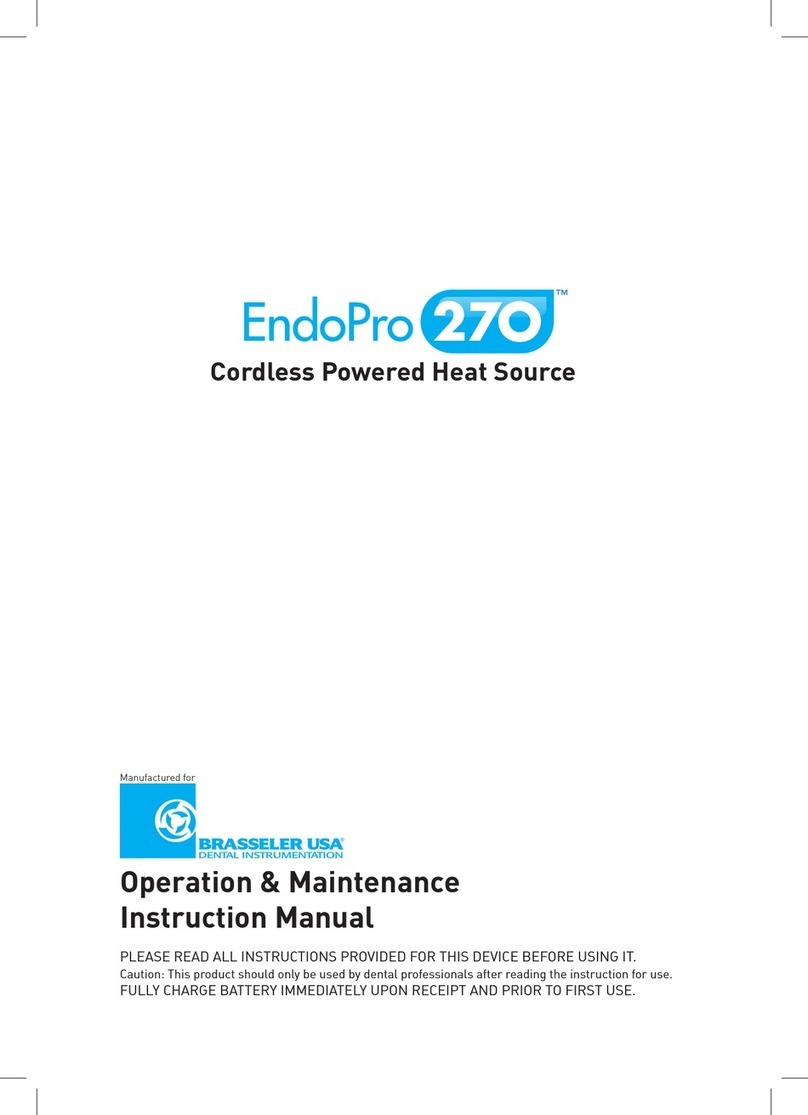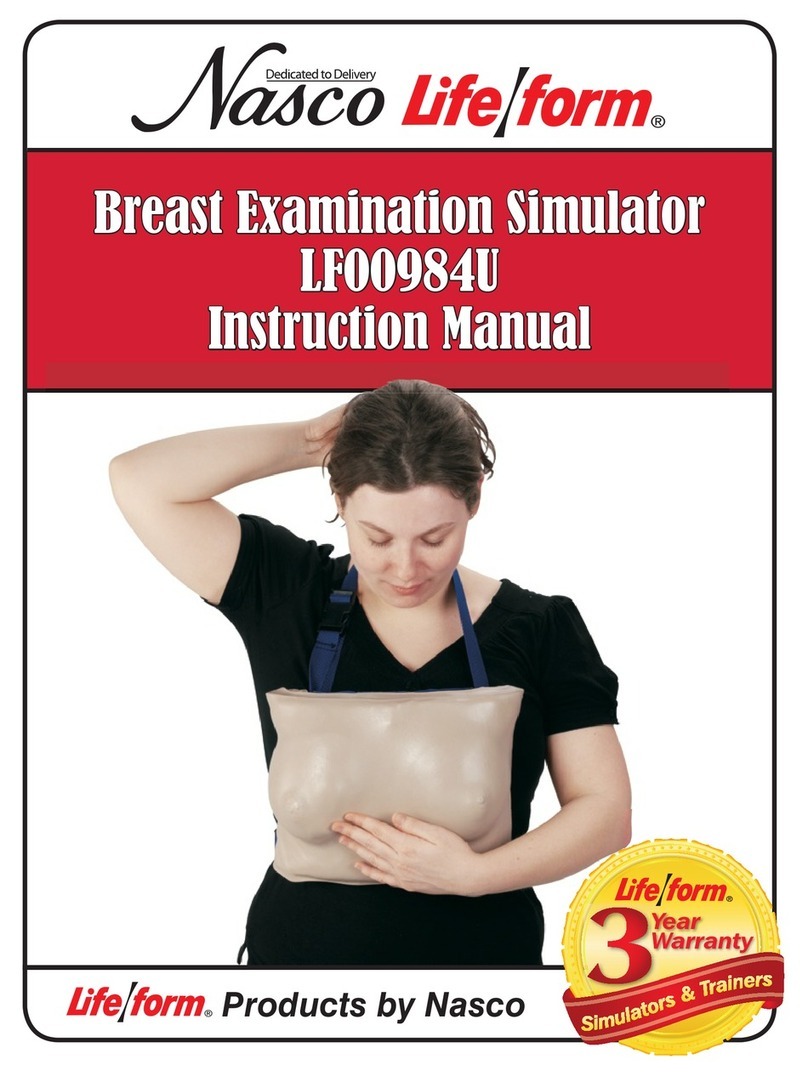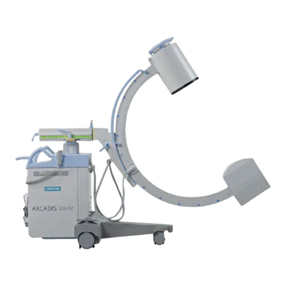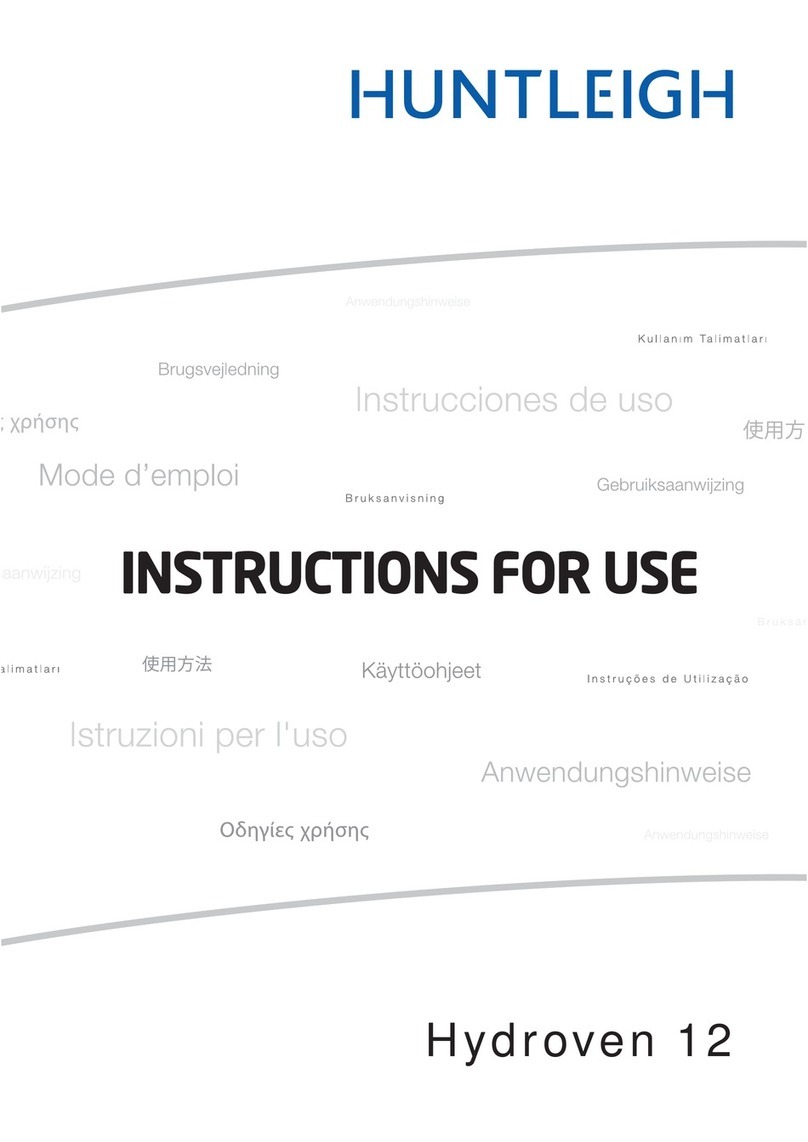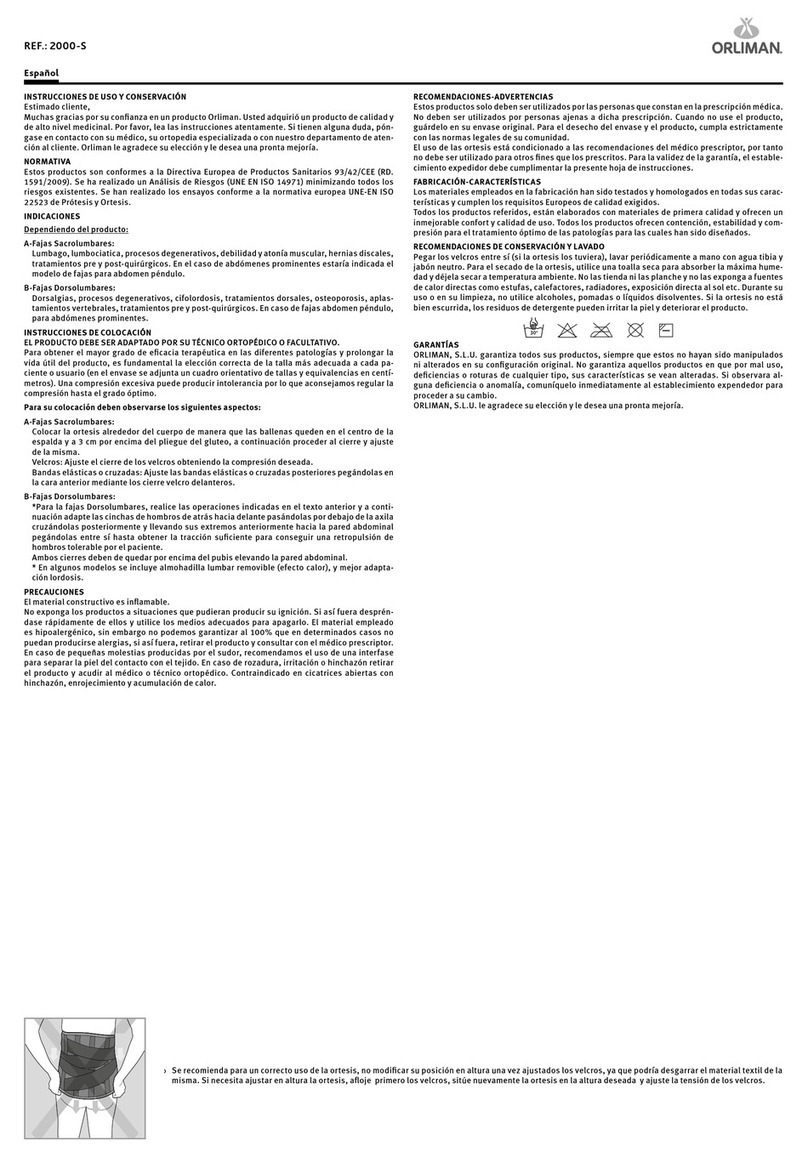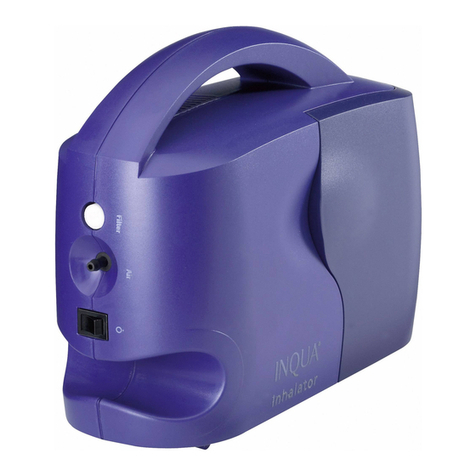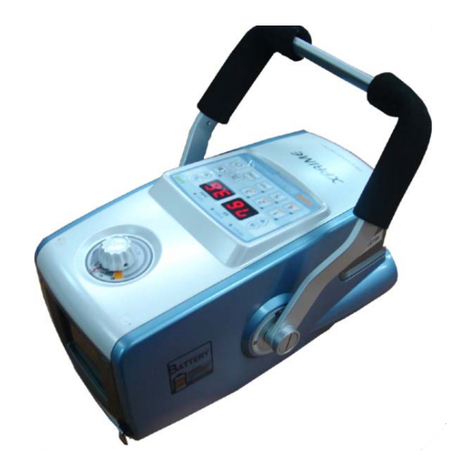BIO-MED DEVICES CROSSVENT-3+ Installation and operating instructions

CROSSVENT-3+
INTENSIVE CARE/TRANSPORT
VENTILATOR
OPERATION & SERVICE MANUAL
CATALOG #3304C
revision: 122606
Bio-Med Devices, Inc.
61 Soundview Road, Guilford, CT 06437
800-224-6633 FAX 203-458-0440
Web Site: www.biomeddevices.com
COPYRIGHT 2005 BIO-MED DEVICES INC.

TABLE OF CONTENTS
I. PATIENT SAFETY, WARNINGS, CAUTIONS AND NOTES.................1
WARNINGS ..............................................................................................................1
CAUTIONS................................................................................................................4
NOTES.......................................................................................................................5
SYMBOLS .................................................................................................................7
II- UNPACKING AND ACCESSORIES.......................................................8
A- UNPACKING .......................................................................................................8
B- ACCESSORIES ....................................................................................................8
III. SPECIFICATIONS, CONNECTIONS AND USER INTERFACE ........9
A- GENERAL DESCRIPTION .................................................................................9
B- SPECIFICATIONS .............................................................................................10
C- MANUAL CONTROLS AND CONNECTIONS ................................................. 11
1- FRONT OF VENTILATOR...................................................................................................... 11
FLOW CONTROL KNOB ........................................................................................................ 11
MAXIMUM PRESSURE KNOB ............................................................................................... 11
PEEP KNOB ............................................................................................................................ 11
AUDIBLE ALARM .................................................................................................................. 11
ALARM LED........................................................................................................................... 11
2- RIGHT SIDE OF VENTILATOR ............................................................................................. 12
GAS SUPPLY INLET .............................................................................................................. 12
GAS SUPPLY WITH BLENDER .............................................................................................. 12
GAS SUPPLY WITH ENTRAINMENT..................................................................................... 12
BLEED EXHAUST .................................................................................................................. 12
3- LEFT SIDE OF VENTILATOR................................................................................................ 12
POWER ON/OFF SWITCH ...................................................................................................... 12
EXTERNAL ELECTRICAL SUPPLY CONNECTOR ................................................................ 13
CHARGING LED & BATTERY ............................................................................................... 13
FLOW SENSOR (PNEUMOTACH) .......................................................................................... 14
OXYGEN SENSOR CONNECTOR........................................................................................... 14
EXHALATION VALVE CONNECTOR .................................................................................... 14
AIRWAY PRESSURE CONNECTOR ....................................................................................... 14
PATIENT GAS CONNECTOR ................................................................................................. 14
ALARM RESET SWITCH ........................................................................................................ 14
4- REAR OF VENTILATOR........................................................................................................ 15
MAXIMUM PRESSURE RELIEF VALVE ................................................................................ 15
NEGATIVE PRESSURE RELIEF VALVE ................................................................................ 15
CE MARK ............................................................................................................................... 15
D- DISPLAY INTERFACE AND MENUS .............................................................. 16
1- DISPLAY OVERVIEW ........................................................................................................... 16
SELECT AND ADJUST A FUNCTION .................................................................................... 16
2- BACKLIGHT& PRESSURE BAR GRAPH ............................................................................... 16
AIRWAY PRESSURE BAR GRAPH......................................................................................... 16
BACKLIGHT........................................................................................................................... 16
3- MAIN MENU.......................................................................................................................... 16
ASSIST CONTROL ................................................................................................................. 17
SIMV....................................................................................................................................... 17

CPAP....................................................................................................................................... 17
MANUAL ................................................................................................................................ 17
PRESSURE TRIGGER ............................................................................................................. 17
PRESSURE SUPPORT ............................................................................................................. 17
RATE ...................................................................................................................................... 18
SIMV RATE ............................................................................................................................ 18
BACKUP RATE....................................................................................................................... 18
TIDAL VOLUME (TV) ............................................................................................................ 18
INSP........................................................................................................................................ 18
I, E, I/E KEY ........................................................................................................................... 18
FLOW KEY ............................................................................................................................. 18
4- ALARM MENUS .................................................................................................................... 19
ALARM MENU KEY............................................................................................................... 19
ALARM PARAMETER RANGES AND ALARM LIMITS ......................................................... 19
ADDITIONAL ALARMS OUTSIDE OF THE ALARM MENUS ................................................ 20
ALARM 3................................................................................................................................ 20
NOTES REGARDING ALARMS .............................................................................................. 21
5- KEYS COMMON TO ALL MENUS......................................................................................... 21
LOCK...................................................................................................................................... 21
ALARM QUIET....................................................................................................................... 21
ARROW KEYS ........................................................................................................................ 22
SIGH ....................................................................................................................................... 22
POWER SOURCE KEY............................................................................................................ 22
INSPIRATORY SOURCE KEY ................................................................................................ 22
SETUP KEY ............................................................................................................................ 23
IV. SETUP AND OPERATING INSTRUCTIONS......................................24
A- INSTALLATION................................................................................................ 24
1. MOUNTING OPTIONS ........................................................................................................... 24
2. POWER CONNECTIONS ........................................................................................................ 24
B- PATIENT CIRCUIT CONNECTIONS...............................................................25
C- OPERATING INSTRUCTIONS.........................................................................26
1- PRELIMINARY STEPS........................................................................................................... 26
2- DETAILED OPERATING INSTRUCTIONS ............................................................................ 26
3- SUMMARY OF OPERATING INSTRUCTIONS ...................................................................... 27
V. SETUP MENU AND TROUBLESHOOTING ........................................28
A- SETUP MENU .................................................................................................... 28
1- OXYGEN SENSOR CALIBRATION ....................................................................................... 28
2- LEAK TEST............................................................................................................................ 28
3- TV/INSP PREFERENCE ......................................................................................................... 28
4- LANGUAGES ......................................................................................................................... 28
5- VER (Version) ........................................................................................................................ 28
6- SN (Serial Number)................................................................................................................. 28
B- CALIBRATION MENU (CAL) ..........................................................................29
C- OPERATIONAL TROUBLESHOOTING .......................................................... 30
VII. CLEANING, STERILIZATION AND PACKING ...............................32
A- CLEANING AND STERILIZATION .................................................................32
B- PACKING FOR SHIPMENT.............................................................................. 33
VIII. THEORY OF OPERATIONS ............................................................35
A- SYSTEM COMPONENTS.................................................................................. 36

SUPPLY GAS INLET FILTER ................................................................................................. 36
SUPPLY PRESSURE SENSING SWITCH ................................................................................ 36
AIRWAY PRESSURE TRANSDUCER ..................................................................................... 36
DIFFERENTIAL PRESSURE TRANSDUCER .......................................................................... 36
MAXIMUM PRESSURE RELIEF VALVE ................................................................................ 36
DIAPHRAGM ACTUATED RELIEF VALVE (D.A.R.V.) ......................................................... 36
NEGATIVE PRESSURE RELIEF VALVE ................................................................................ 36
B- ASSIST CONTROL MODE................................................................................37
C- SIMV (Synchronized Intermittent Mandatory Ventilation) MODE.................. 38
D- CPAP (Continuous Positive Airway Pressure)................................................... 39
E- BACKUP MODALITY ....................................................................................... 40
IX. MAINTENANCE AND SERVICE........................................................41
A- SETUP & CALIBRATION MENU OVERVIEW ............................................... 41
1- SETUP MENU OVERVIEW .................................................................................................... 41
LEAK TEST ............................................................................................................................ 41
INSP/TV.................................................................................................................................. 41
LANGUAGES.......................................................................................................................... 41
VER (Version) ......................................................................................................................... 41
SN (Serial Number).................................................................................................................. 41
2- CALIBRATION MENU OVERVIEW...................................................................................... 41
BATTERY ............................................................................................................................... 42
PRESSURE TRANSDUCER..................................................................................................... 42
FLOW CALIBRATION ............................................................................................................ 42
TOUCHSCREEN (CALIBRATION) ......................................................................................... 42
KEYS (Touchscreen Test) ........................................................................................................ 42
DISPLAY (LCD) TEST ............................................................................................................ 42
VALVES ................................................................................................................................. 43
HOURS ................................................................................................................................... 43
FACTORY SERVICED ............................................................................................................ 43
B- PERFORMANCE CHECKS ............................................................................... 44
1- SETUP MENU ........................................................................................................................ 44
OXYGEN SENSOR CALIBRATION ........................................................................................ 44
LEAK TEST ............................................................................................................................ 44
2- CALIBRATION (CAL) MENU ................................................................................................ 44
KEYS ...................................................................................................................................... 44
DISPLAY ................................................................................................................................ 44
FLOW VERIFICATION ........................................................................................................... 44
FLUSH .................................................................................................................................... 45
POP OFF ................................................................................................................................. 45
3- MAIN MENU.......................................................................................................................... 45
BAR GRAPH ACCURACY ...................................................................................................... 45
PEEP PRESSURE SIGNAL ...................................................................................................... 45
BATTERY ALARM ................................................................................................................. 45
EXTERNAL POWER FAILURE ALARM ................................................................................. 45
POWER FAILURE ALARM ..................................................................................................... 46
SUPPLY PRESSURE ALARM ................................................................................................. 46
ALARM QUIET....................................................................................................................... 46
BACKLIGHT........................................................................................................................... 46
LOCK...................................................................................................................................... 46
RATE ...................................................................................................................................... 46
TIDAL VOLUME ....................................................................................................................46
SIGH ....................................................................................................................................... 46
ALARM MENUS .....................................................................................................................46
SIMV BACKUP RATE............................................................................................................. 46
PRESSURE SUPPORT ............................................................................................................. 47
PRESSURE TRIGGER ............................................................................................................. 47

MANUAL ................................................................................................................................ 47
C- RECOMMENDED TOOLS AND TEST EQUIPMENT ..................................... 48
1- Special Tools and Test Equipment ........................................................................................... 48
D- PREVENTATIVE MAINTENANCE ..................................................................49
1- RECOMMENDED MAINTENANCE SCHEDULE.................................................................... 49
TIMELINE .............................................................................................................................. 49
GAS INLET FILTER................................................................................................................49
BATTERY CHECK.................................................................................................................. 49
2-PREVENTIVE MAINTENANCE PARTS KITS ......................................................................... 49
E-SOFTWARE UPGRADES ................................................................................... 51
F- PNEUMATIC CALIBRATION........................................................................... 52
G- DISASSEMBLY & REASSEMBLY INSTRUCTIONS ...................................... 59
1. REAR PANEL......................................................................................................................... 59
2. BATTERY REMOVAL & REPLACEMENT ............................................................................. 59
3. FRONT BEZEL ....................................................................................................................... 60
4. DISPLAY/TOUCHSCREEN..................................................................................................... 60
5. POPULATED CIRCUIT BOARD (PCB)................................................................................... 60
6. COMPLETE PNEUMATICS AS AN ASSEMBLY .................................................................... 61
7. PNEUMATIC VALVE BRACKET ASSEMBLY ....................................................................... 62
8. FLOW, MAX PRESSURE & PEEP VALVES ........................................................................... 63
9. SOLENOIDS ........................................................................................................................... 64
10. ENTRAINMENT ON/OFF SWITCH....................................................................................... 64
11. GAS INPUT FILTER ............................................................................................................. 65
12. PREVENTIVE MAINTENANCE KITS................................................................................... 65
H- TECHNICAL TROUBLESHOOTING CHART.................................................66
X. PARTS LIST AND SCHEMATIC DIAGRAMS....................................68
A- REPLACEMENT PARTS LIST ....................................................................... 68
B- SCHEMATICS................................................................................................... 69
1- PNEUMATIC SCHEMATICS .................................................................................................. 69
2- PCB BLOCK DIAGRAM......................................................................................................... 71
3- CIRCUIT SCHEMATICS ........................................................................................................ 72
WARRANTY ...............................................................................................83
APPENDIX A .............................................................................................84
ABBREVIATIONS .................................................................................................. 84
APPENDIX B .............................................................................................85
DEFAULT SETTINGS ............................................................................................ 85
APPENDIX C .............................................................................................86
SUMMARY OF PARAMETER RANGES / ACCURACIES ...................................86
APPENDIX D.............................................................................................87
SUMMARY OF DISABLED FUNCTIONS .............................................................87
APPENDIX E .............................................................................................88
AUDIBLE ALARM CODES ....................................................................................88

APPENDIX F .............................................................................................89
CHARGERS AND INVERTERS ............................................................................. 89
APPENDIX G.............................................................................................90
EUROPEAN AGENT ..............................................................................................90
INDEX........................................................................................................91

1
11
1
I. PATIENT SAFETY, WARNINGS, CAUTIONS AND NOTES
The CROSSVENT-3+ ventilator is intended for use only by a qualified practitioner, under the direction of a
qualified physician. All personnel operating the ventilator must be completely familiar with the warnings
and operating procedures in this manual prior to using the CROSSVENT-3+ with patients. As with any life
support device, the patients on the CROSSVENT-3+ should be visually monitored by competent personnel
at all times since life threatening conditions may arise that may not be detected by the alarms. It is essential
to test all life-support devices for proper function prior to each use on patients.
A- WARNINGS, CAUTIONS, AND NOTES
The following terms are used throughout this manual:
WARNING - Indicates a procedure or condition that could cause bodily injury.
CAUTION - Signifies a procedure or condition that could damage the equipment.
NOTE - Refers to a procedure or condition that requires special attention.
WARNINGS
WARNINGSWARNINGS
WARNINGS
• Whenever the CROSSVENT is connected to a patient, a skilled operator should be present at all
times at the ventilator or within hearing range of the ventilator’s alarm system.
• Only qualified medical personnel should operate the ventilator.
• Do not attempt to ventilate a patient until thoroughly familiar with all of the operating instructions.
• The operating instructions are not intended as recommended clinical protocols.
• Always test the ventilator prior to each use. After set up, ventilate a test lung to verify proper
operation prior to connecting the ventilator to a patient.
• If a malfunction should occur, the unit should be removed from use and repaired prior to using it
again on patients.
• Whenever an alarm condition exists it should be rectified immediately. Never allow ventilation with
an alarm condition for an extended length of time.
• High oxygen concentrations may be hazardous to the patient.
• If the gas supply fails or there is a total electrical power failure, the patient may breathe
atmospheric gas through the failsafe valve. This is, however, only a temporary emergency measure,
which requires elevated inspiratory effort and it should be corrected immediately.
• If breathing through the negative pressure relief valve or in the case of entrainment usage, the
operation of the Crossvent in a contaminated environment can be hazardous.
• Always operate the CROSSVENT on battery prior to use to confirm that the battery is functioning.
• In the event of an AC power failure, the CROSSVENT will automatically switch to battery
operation and sound an alarm. The audible alarm may be silenced by pressing the POWER
SOURCE key which will be flashing. On a fully charged battery, there will be approximately 6
hours of autonomous operation. No further alarm will be sounded until the battery is low. The
low battery alarm may be temporarily silenced by pressing the Alarm Quiet key. It is imperative to
restore AC power at this time to assure continued safe operation of the ventilator.
• A patient filter should always be used in the patient breathing circuit to prevent cross
contamination.

I.
I.I.
I.
PATIENT SAFETY
PATIENT SAFETYPATIENT SAFETY
PATIENT SAFETY-
--
- C
CC
CONT.
ONT.ONT.
ONT.
2
22
2
• Extreme care should be taken to assure that the patient circuit components are connected
correctly. Improper connection can cause malfunction.
• Periodically the CROSSVENT-3+ should be operated in the test mode to ascertain that it is
functioning properly. A test lung should be ventilated prior to each use to further insure that all
modes are functioning correctly. An external spirometer should be used to verify correct volumes
and flow rates.
• The patient should never be left unattended after the ALARM QUIET key is depressed since this is
followed by a period when the audible alarms are deactivated.
• An audible alarm always indicates an anomalous state which should always be rectified.
• While some alarms may be turned off to permit use of the CROSSVENT without them, it is
recommended that they be used at all times.
• Always be certain that the Maximum Pressure Limit is set correctly and is operative even when
volume limiting, to prevent possible inadvertent administration of high pressure. Increased
pressure can be caused by blocked tubes, changes in patient compliance or resistance, or system
malfunction.
• The alarm ports on the front of the CROSSVENT should never be obstructed.
• For proper operation only the O2sensor supplied by Bio-Med Devices may be used.
• Never operate the CROSSVENT-3+ without a battery since it will fail to operate if the plug-in
power supply is removed.
• The screened ports on the side, back, and bottom of the unit should not be obstructed when the
ventilator is in use.
• Only qualified, trained, service technicians should attempt repairs and service when needed.
Serious personal injury and/or equipment damage can result if repairs are performed by unqualified
personnel
• It is imperative to verify that clinically appropriate alarm limits are fully operational following
connection of the ventilator to a patient.
• It is important to note that once a sensor has been turned off, the alarms for that sensor are
inoperative.
• Breathing through the negative pressure relief valve requires a greatly increased work of breathing
and only air is provided. A situation in which the patient is breathing through this valve should be
rectified immediately in order to prevent possible adverse affects to the patient.
• It is extremely important that the Pressure Trigger control be carefully adjusted to assure proper
operation in the CPAP mode.
• When in SIMV, it is important to always set a correct SIMV RATE, TIDAL VOLUME and FLOW
to insure proper ventilation in case the patient becomes apneic.
• When in CPAP, it is important to always set a correct BACKUP RATE, TIDAL VOLUME and
FLOW to insure proper ventilation in case the patient becomes apneic.
• To obtain the full 3-minute duration of the Power Failure alarm, the Crossvent must have been
powered on for at least 1 minute.
• All safety measures must be observed when servicing this device. In particular, the ventilator must
be turned off and the power supply disconnected.
• Bio-Med Devices cannot be held responsible for any failure to adhere to the recommendations set
forth in this manual.

I.
I.I.
I.
PATIENT SAFETY
PATIENT SAFETYPATIENT SAFETY
PATIENT SAFETY-
--
- C
CC
CONT.
ONT.ONT.
ONT.
3
33
3
• Because this is a CE marked device, it must never be modified without prior expressed written
consent from Bio-Med Devices.
• When setting Pressure Trigger, auto-triggering or missed breaths may occur due to various
conditions including, but not limited to, compliance, resistance, rate, flow, PEEP, I:E ratio, and
circuit characteristics.
• Do not re-use disposable breathing circuits.
• Operation of the Crossvent in a contaminated environment can be hazardous when entrainment is
used.
• It is extremely important that the Pressure Trigger control be carefully adjusted to assure proper
operation in the SIMV and CPAP modes. Also, under certain conditions in SIMV with PEEP,
even though the low peak pressure alarm is set correctly for assisted breaths, there may be no low
peak pressure alarm following a patient disconnect until the next assisted breath. This period may
be up to 2 minutes.
• Improper changes made in the Calibration menu can be detrimental to the performance of the
ventilator.
• Do not apply tension to the flow sensor (pneumotach) tubing. Do not allow the sensor to be in the
patient circuit when not connected to the ventilator.
• In rare instances, when using the Crossvent with an air/oxygen blender, there may be a reduction in
the delivered flow at the higher flow settings. This reduction may occur when the blender is set
below 30% or above 90% O2and the Crossvent is set to flows above 80 lpm. Lower supply
pressures to the blender will tend to decrease the flow further so be sure these supply pressures are
maintained at 45- 75 PSI (310-517 kPa). If the Crossvent has the exhaled tidal volume monitoring
feature, it is recommended this be used to ensure proper tidal volumes are being delivered. If it
does not have this feature, then an external spirometer is recommended.

I.
I.I.
I.
PATIENT SAFETY
PATIENT SAFETYPATIENT SAFETY
PATIENT SAFETY-
--
- C
CC
CONT.
ONT.ONT.
ONT.
4
44
4
CAUTIONS
CAUTIONSCAUTIONS
CAUTIONS
• Clean, dry, medical grade gas sources supplied at 31 to 75 psi (303.6 – 517.4 kPa) unrestricted flow
must be used at all times to assure proper operation of the CROSSVENT Ventilator. If an
air/oxygen blender is used, then 45 – 75 PSI (310 – 517 kPa) should be supplied to the blender.
• The CROSSVENT should not be steam or gas sterilized as this will result in damage to some of its
components.
• Connect the oxygen sensor (optional) upstream of the humidifier since the fuel cell functions better
in non-humidified gas.
• Touchscreen control keys should be pressed by hand only. Care should be taken not to allow keys
to be contacted by sharp objects as damage may result.
• Clean touchscreen only with alcohol. Clean the rest of the CROSSVENT unit with mild, non-
abrasive, anti-bacterial cleanser.
• Do not place liquids on or near the CROSSVENT. Liquid entering the unit can cause severe
damage and malfunction.
• It is recommended that the CROSSVENT never be left with its battery discharged as this will
reduce battery life. After discharge of the battery, recharge fully before disconnecting the plug-in
power supply.
• Only replace the battery pack with Bio-Med Devices part #PRT4467. Do not substitute. The cells
are non-standard high capacity.
• When using an AC power source, only the power supply provided with the Crossvent is approved
for use with this ventilator. Any other power supply may cause damage and/or unreliable
operation (see Appendix F).
• Any more comprehensive DC power supply than that which is supplied must be short circuit
protected and must comply with all of the specifications and standards as listed in Section III, Part
B.
• Do not use in a MRI room.
• Antistatic or electrically conductive hoses or tubing should not be used.
• When it is necessary to operate the Crossvent from an AC inverter, only inverters in compliance
with NEMA standards should be used (see Appendix F).
• Prior to turning the unit on for the first time, the battery must be charged fully using the included
power supply.
• Do not apply tension to the flow sensor tubing. Do not allow the sensor to be in the patient circuit
but not connected to the ventilator when ventilating.
• Do not allow the temperature of the battery to go above 131° F (55° C) whether the unit is on or
off as this may cause damage resulting in a shorter life expectancy of the battery.

I.
I.I.
I.
PATIENT SAFETY
PATIENT SAFETYPATIENT SAFETY
PATIENT SAFETY-
--
- C
CC
CONT.
ONT.ONT.
ONT.
5
55
5
NOTES
NOTESNOTES
NOTES
• With entrainment on, flow accuracy from 5 - 100 lpm is ±10% or 1 lpm, whichever is greater, and
with a flow of 100 lpm and over, flow accuracy is within 15% of displayed flow. No accuracy is
claimed below 5 lpm.
• When the CROSSVENT is turned on, it automatically recalls all of the settings stored in memory
before it was turned off. The parameters stored are: all the main functions; high and low alarm
limits; secondary modes; which sensors are on or off. Several factors can cause the battery backed
memory to be lost. These are: low battery backed memory battery voltage (service required);
defective random access memory (service required); or if the microprocessor is, by chance, storing
data in the battery backed memory at the time power is turned off. In this case it is necessary to
re-enter the previously set parameters.
• The Maximum Pressure should always be set higher than PEEP in order to achieve the PEEP
setting.
• While connected to an active gas source, the Maximum Pressure and PEEP controls should be
turned off (fully counter clockwise) when the Crossvent is not in use to conserve gas.
• The Power Failure alarm may not be silenced using the Alarm Quiet key. The Power Failure alarm
may be silenced by pressing the alarm reset button.
• Pressure Support is only active during SIMV and CPAP, but may be set at any time.
• The wall plug-in power supply is furnished for 117 VAC, 60 Hz or 220 VAC, 50 Hz operation, as
required. It is not possible to overcharge the battery. Always keep the battery fully charged when
not in use.
• It is important to use the correct reference gases (100 and 21%) when performing the Oxygen
sensor calibration. A worn out sensor will not calibrate accurately.
• Since it is not possible to damage the CROSSVENT ventilator by normal use of its keys and
control knobs, the user is encouraged to experiment with the CROSSVENT settings while the unit
is not connected to a patient.
• A highlighted field on the display indicates that a parameter has been selected and may be adjusted
using the arrow keys.
• If it is desired to deactivate the oxygen sensor, select it and scroll the lower limit down to OFF.
The oxygen function is now inoperative. The function may be reactivated at any time by pressing
it and scrolling the low limit up. The oxygen sensor is now reactivated. This allows the ventilator
to be used without the oxygen sensor. When this sensor is off, it may be disconnected while the
ventilator is in use, without causing an alarm.
• For blended gas, the Bio-Med Devices blender should be used.
• It is recommended that an external filter/water trap be used at all times in order to provide greater
protection to the internal components of the CROSSVENT.
• For greatest accuracy, verify flow using a 60% O2 gas supply, making certain that the pressure to
the CROSSVENT inlet remains within specified pressure limits (31-75 psi; 303.6 –517.4 kPa) at all
flows.
• When the Crossvent is first turned on and is in battery mode, if a period longer then 60 seconds
passes and the BATTERY key has not been pushed, an audible alarm will sound. When the
BATTERY key is pushed, the audible alarm will be silenced.
• Due to the fact that O2 sensors sometimes change output over time once exposed to atmosphere, a
calibration should be performed periodically (once a month) in order to assure optimal accuracy.
When the sensor is consumed and does not calibrate properly, it should be discarded and a new
sensor installed and calibrated.

I.
I.I.
I.
PATIENT SAFETY
PATIENT SAFETYPATIENT SAFETY
PATIENT SAFETY-
--
- C
CC
CONT.
ONT.ONT.
ONT.
6
66
6
• It is not recommended that entrainment be turned on or off while ventilating. However, if this
should become necessary, then it should be done during the expiratory phase of the breathing
cycle. Be aware that this will change the flow.
• Approximately twenty minutes of operation will remain after a low battery alarm assuming a
properly maintained battery in good condition.
• The battery should be replaced at least every two years. Only use batteries supplied by Bio-Med
Devices, part #PRT4467.
• Prior to disposal of any component, with particular attention to the battery and PCB, check with
your local controlling authority for disposal regulations.
• When first turned on, the unit displays “Bio-Med Devices, Inc.” until the initialization process is
complete. If this does not clear, submit unit for service.
• Be aware that the SIMV rate is also the backup rate which is the rate the patient will get in the event
of apnea.
• While scrolling a parameter, some hesitation may be observed.

I.
I.I.
I.
PATIENT SAFETY
PATIENT SAFETYPATIENT SAFETY
PATIENT SAFETY-
--
- C
CC
CONT.
ONT.ONT.
ONT.
7
77
7
SYMBOLS
SYMBOLSSYMBOLS
SYMBOLS
Type BF Equipment
Date of Manufacture
Direct Current (DC)
It is essential that these instructions be read and complied with prior to operating
this product.
Must be disposed of in accordance with WEEE Directive.
At the unit’s “end of life”, it may be returned to the manufacturer for proper
reclamation.
Do not rotate the power supply plug when it is engaged with the jack.
Power On
Power Off/Valve Closed
Valve Open

8
88
8
II- UNPACKING AND ACCESSORIES
A
AA
A-
--
- UNPACKING
UNPACKINGUNPACKING
UNPACKING
CAUTION: Prior to turning the unit on for the first time, the battery must be charged fully
using the included power supply.
Examine the CROSSVENT carton to ascertain whether it has sustained any damage during shipment.
Inspect the contents of the shipping carton. If any damage to the product is observed, notify the carrier at
once. Only you, the consignee, can make a claim against the carrier for damage in shipment..
Once the Crossvent and accessories have been removed from the packaging and passed visual inspection,
place the unit in a location where it will be within reach of a standard AC outlet. Plug the separate AC
power cord into the accompanying power supply and then plug this cord into the standard AC outlet. Plug
the locking connector from the power supply, red dot facing to the front of the Crossvent, into the Power
Connector on the left side of the unit just below the ON/OFF switch. Once plugged in, the charging LED
above will begin to blink slowly (approximately once per second) indicating it is charging. (Rapid blinking
indicates a problem with the charging and Technical Support should be contacted at 800-224-6633).
Charge the unit until the green charging indicator stops blinking and remains solidly lit. This indicates the
battery is fully charged. This may take up to five hours depending on the state of the battery when the unit
was received.
Refer to the performance checks in the service section of this manual prior to placing this ventilator into
service.
B
BB
B-
--
- ACCESSORIES
ACCESSORIESACCESSORIES
ACCESSORIES
The following is a list of the equipment supplied with the CROSSVENT-3+ Intensive Care/Transport
Ventilator. Additional accessories available for the Crossvent may be found on our website at
www.biomeddevices.com.
Quantity. Cat. No. Description
1 3300C CROSSVENT-3+ Ventilator
1 2002K1Air/Oxygen Blender
1 2013 Pole Mounting Bracket
1 1010 High Pressure Supply Hose – Oxygen
1 PFIT1502DISS Male to Male Coupler
1 10112High Pressure Supply Hose - Air
1 80011 Disposable Adult Breathing Circuit
1 1020 Test Lung
1 4401 Disposable Patient Filter
1 44101Disposable Pediatric/Adult Pneumotach
1 4434 Oxygen Sensor Cell w/2.5mm Plug
1 4418 Oxygen Sensor Cell Tee
1 44141Oxygen Filter/Water Trap
1 44153Air Filter/Water Trap
1 3304C Instruction Manual
21202Blender Instruction Manual
1 -------- Warranty Card
1 4419A Charger w/Cord, U.S.A. AC Adapter
1 4419B3Charger w/Cord, International AC Adapter
NOTE: 1 - OPTIONAL
2 - STANDARD WITH BLENDER
3- STANDARD WITH INTERNATIONAL ORDERS

9
99
9
III. SPECIFICATIONS, CONNECTIONS AND USER INTERFACE
A
AA
A-
--
- GENERAL DESCRIPTION
GENERAL DESCRIPTIONGENERAL DESCRIPTION
GENERAL DESCRIPTION
The CROSSVENT-3+ Intensive Care/Transport Ventilator is an ultra compact, electronically controlled,
time cycled, volume or pressure limited ventilator with intensive care capabilities. It provides a wide range
of operating parameters to allow ventilatory support of patients from pediatric through adult. The
CROSSVENT-3+ delivers the same oxygen concentration as the supply gas unless the optional entrainment
is in use in which case it is a nominal 50% O2.
The ventilator’s microprocessors provide all operational functions, as well as monitoring the patient and
providing alarms. It allows the user to enter many different operational and alarm parameters to
accommodate a wide variety of clinical situations.
Airway pressure is sensed using an internal pressure transducer, and pressure is displayed as a bar graph on
the LCD. The patient inspiratory effort is also sensed using a pressure transducer. An absolute pressure
transducer monitors atmospheric pressure and automatically compensates the displayed flow for altitude
changes.
Since the CROSSVENT-3+ is totally separable from a compressor and since it may be used with any 31 to
75 psi (214 – 517 kPa) psi gas source, it is extremely versatile. It may be used in most areas of the hospital
and in transport. It may be mounted on a compressor, on a pedestal stand, a cart, a wall bracket, or a bed
rail. It may also be mounted in vehicles such as helicopters and ambulances.
CAUTION: Do not use in a MRI room.
The CROSSVENT-3+ has an internal battery which provides power during transport and in the event of an
AC power failure. If the external power should fail, the ventilator automatically switches to its internal
battery and sounds an alarm. The battery operation is approximately 6 hours on a fully charged battery. If
more time than that is required, the backlight may be turned off as described in this manual. Whenever
external power is restored, the CROSSVENT-3+ switches back to external power operation. It will charge
the battery whenever external power is available.
The CROSSVENT-3+ Ventilator’s extreme reliability is made possible by:
• An absolute minimum of moving parts.
• An extremely low total parts count.
In addition to increased patient safety, the high reliability insures low downtime and thus more economical
use.
The CROSSVENT-3+ provides a complete array of features and ventilatory modes and functions which
include:
• Microprocessors control of all operational functions and monitoring.
• A Graphic LCD (liquid crystal display) with a touchscreen keypad, allowing the clinician to select
functions just by pressing the function displayed by the LCD. This provides the friendliest and
most flexible possible user interface.
• Automatic switch-over to battery backup operation.
• Auto-test mode with complete microprocessor diagnostics.
• Sensors to measure airway pressure, oxygen concentration (optional).
• Exhaled Tidal Volume and Minute Volume displays & alarms (optional).
• Displays and alarms for Peak Pressure, Rate, Mean Pressure, PEEP Pressure and Oxygen
concentration and more.
• Programmability and expandability.
• Built-in triggered demand flow for minimum work of breathing during SIMV and CPAP and a
simplified system design.
• Integral ASSIST CONTROL, SIMV, CPAP, PEEP, and Pressure Support functions.
• Altitude Compensation
• RS-232 input for PC interface for software updates.

III. SPECIFICATIONS, CONNECTIONS & USER INTERFACE cont’d.
10
1010
10
B
BB
B-
--
- SPECIFICATIONS
SPECIFICATIONSSPECIFICATIONS
SPECIFICATIONS
Rate 5 – 150 bpm
Inspiratory Time 0.1 – 3 seconds
Tidal Volume 5 – 2500 ml
Flow Rate 1 – 120
Inspiratory Time 0.10 – 3.0 seconds
I:E Ratio 3:1 to 1:99
Peak Pressure 0 – 120 cmH2O
PEEP Pressure 0 - 35 cmH2O
Pressure Trigger -0.2 to –10 cmH2O
Pressure Support 0 – 50 cmH2O
SIMV Rate 0.6 – 50 bpm
Sigh 0 - 2500 ml
Maximum Safety Pressure: 120 cmH2O
Pneumatic Power Source: 31 to 75 psi (214 – 517 kPa)1
Audible Alarm Characteristics: 90 dB at 10cm (25°C)
Electrical Power Source:
See Appendix F at the beginning of the manual
Output: 16.0 VDC, 3 A
Output Protection: Short Circuit and Overload
Isolation: Meets IEC601.1, classification BF, UL 544 Patient Care, CSA 125
Risk Class 2G
Maximum Ripple: <100 mVp-p
Safety: Approved to UL 544/2601.1, CLU (CSA) 22.1 #125/601.1, TUV
EN60601.1 & CE LVD
EMC: Designed to Level B Requirements of FCC part 15, CISPR11
(EN55011). Less than 1 Volt Output Deviation for IEC801-2, 3,
4, 5, Immunity Tests.
Overall Dimensions
Height: 10" (25.4 cm)
Width: 11" (28.0 cm)2
Depth: 5.5" (14 cm)
Weight: 10.5 lbs. (4.8 kg)3
Operating Temperature: 32° to 104° F. (0° to 40° C)4
Storage Temperature: 32° to 122° F. (0° to 50° C)4
1- If an air/oxygen blender is used, then 45 – 75 PSI (310 – 517 kPa) should be supplied to the blender.
2- 14.25” (36.2 cm) with optional mounted blender
3- 13.25 lbs. (6 kg) with optional mounted blender
4- When using the oxygen sensor, then 41° – 104° F (5° – 40° C); battery will not fast charge below 41° F (5° C) nor above
125° F (51° C).

III. SPECIFICATIONS, CONNECTIONS & USER INTERFACE cont’d.
11
1111
11
C
CC
C-
--
- MANUAL CONTROLS AND CONNECTIONS
MANUAL CONTROLS AND CONNECTIONSMANUAL CONTROLS AND CONNECTIONS
MANUAL CONTROLS AND CONNECTIONS
1
11
1-
--
- FRONT OF VENTILATOR
FRONT OF VENTILATORFRONT OF VENTILATOR
FRONT OF VENTILATOR
FLOW CONTROL KNOB
FLOW CONTROL KNOBFLOW CONTROL KNOB
FLOW CONTROL KNOB
Adjusting this knob sets the inspiratory flow from 0 - 120 lpm. The
Flow setting is displayed in the FLOW key on the display. It is
accurate from 1 to 120 lpm.
WARNING: In rare instances, when using the
Crossvent with an air/oxygen blender, there may be a
reduction in the delivered flow at the higher flow
settings. This reduction may occur when the blender is
set below 30% or above 90% O2and the Crossvent is set
to flows above 80 lpm. Lower supply pressures to the
blender will tend to decrease the flow further so be sure
these supply pressures are maintained at 45- 75 PSI
(310-517 kPa). If the Crossvent has the exhaled
tidal volume monitoring feature, it is
recommended this be used to ensure proper tidal
volumes are being delivered. If it does not have this feature, then an external
spirometer is recommended.
NOTE: With the optional entrainment on, flow accuracy from 5 - 100 LPM is ±10% or 1 LPM, whichever
is greater, and with a flow of 100 LPM and over, flow accuracy is within 15% of displayed flow. No accuracy
is claimed below 5 LPM.
When air entrainment is on, verify the message “ENTRN” is displayed in the Inspiratory Source Key.
Set the FLOW after entrainment is turned on since the flow calibration is automatically adjusted for
entrainment. It is not recommended that entrainment be turned on or off while ventilating. However, if this
should become necessary, then it should be done during the expiratory phase of the breathing cycle. Be aware
that this will change the flow.
MAXIMUM PRESSURE KNO
MAXIMUM PRESSURE KNOMAXIMUM PRESSURE KNO
MAXIMUM PRESSURE KNOB
BB
B
Adjusting this knob sets the pressure applied to the exhalation valve and to an internal adjustable relief
valve. This determines the maximum pressure during assisted and controlled inspirations. It is adjustable
from 0 - 120 cmH2O. It should always be operative and properly adjusted.
NOTE: While connected to an active gas source, the Maximum Pressure control should be turned off (fully
counter clockwise) when the Crossvent is not in use to conserve gas.
PEEP KNOB
PEEP KNOBPEEP KNOB
PEEP KNOB
(Positive End Expiratory Pressure)- Adjusting this knob sets the PEEP or CPAP (Continuous Positive
Airway Pressure) level applied to the exhalation valve. It is adjustable from 0- 35 cmH2O. The PEEP level
is determined by observing the system pressure bar graph or with the PEEP/CPAP readout on the
secondary alarm menu.
NOTE: The Maximum Pressure should always be set higher than PEEP in order to achieve the PEEP
setting.
NOTE: While connected to an active gas source, the PEEP control should be turned off (fully counter
clockwise) when the Crossvent is not in use to conserve gas.
AUDIBLE ALARM
AUDIBLE ALARMAUDIBLE ALARM
AUDIBLE ALARM
Located next to the BMD logo on the front of the unit, it emits the audible tones to indicate an alarm
condition or keyboard actuation.
WARNING: It should never be obstructed.
NOTE: Refer to Appendix E for all the beeper codes.
ALARM
ALARMALARM
ALARM LED
LEDLED
LED
This flashes on and off in equal duration during any alarm providing 360-degree visibility. When unit is
turned off or loses power, it flashes for 3 minutes. This time may be less if the Crossvent was not powered
on for at least 1 minute prior to loss of power.
FIG. 1- FRONT VIEW
A/C
OFF
+
3
FLOWMAX PRESS PEEP

III. SPECIFICATIONS, CONNECTIONS & USER INTERFACE cont’d.
12
1212
12
2
22
2-
--
- RIGHT SIDE OF VENTILATOR
RIGHT SIDE OF VENTILATORRIGHT SIDE OF VENTILATOR
RIGHT SIDE OF VENTILATOR
FIG. 2- RIGHT SIDE VIEWS
CAUTION: Antistatic or electrically conductive hoses or tubing should not be used.
GAS SUPPLY INLET
GAS SUPPLY INLETGAS SUPPLY INLET
GAS SUPPLY INLET
Male DISS 9/16-18 fitting. Clean, dry, medical grade gas, delivered at 31 to 75 psi (214 – 517 kPa) pressure
at 132 lpm is required. These requirements apply to the inlet of the ventilator in order to ensure proper
flows. If the supply pressure falls below 31 psi, an internal sensor will detect this and the Crossvent will
alarm. A serviceable 40-micron filter is contained within the supply fitting.
GAS SUPPLY WITH BLEN
GAS SUPPLY WITH BLENGAS SUPPLY WITH BLEN
GAS SUPPLY WITH BLENDER
DERDER
DER
When using a blender, oxygen and air supplies are connected to the blender and the output of the blender is
then connected to the Crossvent Supply Inlet. For optimum performance, 45 – 75 PSI (310 – 517 kPa)
should be supplied to the blender. Oxygen concentrations set by the blender are then delivered to the
patient. Refer to the Blender Operation Manual for instruction on its use.
GAS SUPPLY WITH ENTR
GAS SUPPLY WITH ENTRGAS SUPPLY WITH ENTR
GAS SUPPLY WITH ENTRAINMENT
AINMENTAINMENT
AINMENT
When equipped with the optional Air Entrainment Module, the CROSSVENT is able to supply either 100%
or 50% (nominal) oxygen during transport, without the use of compressed air. A unique feature of the
entrainment system is the ability to deliver repeatable volumes during volume limited ventilation, with
relatively constant oxygen concentration.
When using entrainment, the source gas should be 100% O2. When the air entrainment control on the right
side of the CROSSVENT is turned to the ON position, a sophisticated, multiple venturi system is activated,
which draws in ambient air and dilutes the 100% O2 supply gas to a nominal 50% concentration.
An additional advantage of using entrainment is that the oxygen supply consumption will be reduced,
thereby increasing the operating time on a given supply of gas.
When entrainment is off, the gas delivered is the same as is connected to the supply inlet.
WARNING: Operation of the Crossvent in a contaminated environment can be
hazardous when entrainment is used.
BLEED EXHAUST
BLEED EXHAUSTBLEED EXHAUST
BLEED EXHAUST
Internal bleeds from the pneumatic controls exhaust through this screened port.
This area must not be obstructed when the ventilator is in use.
3
33
3-
--
- LEFT SIDE OF VENTILATOR
LEFT SIDE OF VENTILATORLEFT SIDE OF VENTILATOR
LEFT SIDE OF VENTILATOR
POWER ON/OFF SWITCH
POWER ON/OFF SWITCHPOWER ON/OFF SWITCH
POWER ON/OFF SWITCH
It is located on the left side of the unit and is recessed in order to reduce
inadvertent or unauthorized use. It controls the main power to the electronics.
If the battery is allowed to fall below 6 volts (well below the Low Battery alarm
limit) with the unit operating, the ventilator will turn off independently of this
switch. If this occurs, this switch must be turned to OFF before the ventilator
will operate again, regardless of power source.
WARNING: Never use the On/Off switch to silence the alarms
since this renders the alarms permanently disabled.
FIG. 3- LEFT SID
E
POWER
ON
OFF
EXH
VALVE
AIRWAY
PRESSURE
NEBULIZER
PATIENT
ALARM
RESET
O2
!
FLOW SENSOR
CHARGING

III. SPECIFICATIONS, CONNECTIONS & USER INTERFACE cont’d.
13
1313
13
EXTERNAL ELECTRICAL
EXTERNAL ELECTRICALEXTERNAL ELECTRICAL
EXTERNAL ELECTRICAL SUPPLY CONNECTOR
SUPPLY CONNECTORSUPPLY CONNECTOR
SUPPLY CONNECTOR
This receptacle accepts the plug from the factory supplied, U.L. approved, power supply module. The plug
and receptacle are keyed so they will only go together when the red dot on the plug faces to the front of the
unit and the cord is within the two arms of the guard. By necessity, this power supply meets all the
specifications and standards listed in Section III, Part B. Use only Jerome Industries model WSZ116M
(16VDC, 3A) with the appropriate mating plug. The Crossvent should not be used with any other wall plug-
in or desktop AC adapter. This is used to operate the ventilator and to charge the battery whenever it is
below full charge. The wall plug-in power supply is furnished for 117 VAC, 60 Hz or 220 VAC, 50 Hz
operation, as required. It is not possible to overcharge the battery. Always keep the battery fully charged
when not in use.
CAUTION: Do NOT attempt to rotate the power connector while it is plugged into the
ventilator. It must only be pushed straight in and pulled straight out.
CAUTION: When using an AC power source, only the power supply provided with the
Crossvent is approved for use with this ventilator. Any other power supply may cause
damage and/or unreliable operation.
CAUTION: Any more comprehensive DC power supply than that which is supplied must
be short circuit protected and must comply with all of the specifications and standards as
listed in Section III, Part B.
CAUTION: When it is necessary to operate the Crossvent from an AC inverter, only
inverters in compliance with NEMA standards should be used (see Appendix F).
CHARGING LED & BATTE
CHARGING LED & BATTECHARGING LED & BATTE
CHARGING LED & BATTERY
RYRY
RY
The Charging LED indicates the charging mode when the external power supply is plugged into the
Crossvent. Its states are:
1. Slow Blinking (approximately once per second)- unit is in rapid charge mode.
2. Rapid Blinking- failure in the charging system or the temperature of the battery was above 125°F
(40°C) when the external power supply was connected.
3. On Steady- trickle charge mode.
The battery operation is approximately 6 hours on a fully charged battery. Turning off the backlight can
extend this time (refer to Backlight in Part D of this section).
To charge the battery, only the power supply provided by Bio-Med Devices should be used. With the red
dot on the supply’s connector facing the front of the Crossvent, plug the external power supply into the side
of the unit and into an AC outlet. Charge the battery until the charging LED indicates it is in trickle charge
mode and the battery is fully charged (solid LED). The amount of time required to fully charge the battery
depends on many factors, including the state of charge when it begins. The maximum time for an exhausted
battery is approximately 5 hours. When done, verify battery power by unplugging the external power cord
from the side of the unit while it is turned on. The Crossvent should alarm and the power source key at the
bottom of the display should flash “BATT”. Press this key to cancel this alarm. The battery bar indicating
the remaining battery power should span the entire battery key unless the battery was fully discharged, in
which case it may only indicate 90%. This condition will self-correct with further charging cycles.
If the temperature of the battery is over 125°F (51°C), it cannot accept a charge. This situation should be
avoided. If the battery reaches this temperature during a rapid charge, it will go into trickle charge mode
until it is below this temperature.
CAUTION: Do not allow the temperature of the battery to go above 131° F (55° C)
whether the unit is on or off as this may cause damage resulting in a shorter life expectancy
of the battery.
When the state of the battery is determined to be within approximately 20 minutes of remaining autonomous
operation, the Alarm 3 menu will flash “LOW BATTERY, CONNECT EXTERNAL POWER” and sound
the audible alarm. The ventilator should be switched to external power or removed from service and
recharged when this alarm occurs. If the battery is allowed to expend energy to a point below 6 volts (well
below the Low Battery alarm limit), the ventilator will shut down independent of the On/Off switch. If this
occurs, the external power supply must be used to recharge the battery and the On/Off switch must be
turned to Off and then back to On before the unit will operate.
NOTE: 20 minutes of operation after the low battery alarm assumes a properly maintained battery in good
condition.
The NiMH rechargeable battery is located internally and should only be accessed by trained service
personnel. To prolong life and maintain performance, it is recommended that the Crossvent be stored with
the power supply plugged in or with the battery fully charged at a relative humidity of 65% (±20%)

III. SPECIFICATIONS, CONNECTIONS & USER INTERFACE cont’d.
14
1414
14
whenever possible. Because NiMH batteries will naturally “self-discharge”, it is strongly recommended the
battery be cycled through at least one charge/discharge according to the table below if left off the power
supply for an extended period of time.
Storage Temperature Range Time to Charge/Discharge
104°F to 122°F (40°C to 50°C) Less than 30 Days
86°F to 103°F (30°C to 39°C) 30 to 60 Days
32°F to 85°F (0°C to 29°C) 61 to 90 Days
WARNING: Never operate the CROSSVENT without a battery since it will fail to
operate if the plug-in power supply is removed.
CAUTION: The battery should be replaced at least every two years. Only use batteries
supplied by Bio-Med Devices, part #PRT4467. Do not substitute.
FLOW SENSOR (PNEUMOT
FLOW SENSOR (PNEUMOTFLOW SENSOR (PNEUMOT
FLOW SENSOR (PNEUMOTACH)
ACH)ACH)
ACH)
The pneumotach (use is optional) plugs in here and permits the measurement of flow, which is used to
display Exhaled Tidal (or Minute) Volume. Only the pediatric/adult pneumotach can be used with this
ventilator. If any other pneumotach is plugged in, a warning will be displayed in the Alarm 1 menu.
CAUTION: Do not apply tension to the flow sensor tubing. Do not allow the sensor to be
in the patient circuit but not connected to the ventilator when ventilating.
CAUTION: The pressure connection tubes of the pneumotach should always be mounted
vertically to prevent collection of condensate in the pressure tubes. The tubes should be
inspected periodically and condensate should be removed. This condensate may cause
erroneous readings and thus improper operation of the CROSSVENT. Never block these
connections with the unit operating as this can damage the internal transducer. Always
securely connect the pneumotach to its connector before inserting the pneumotach in the
flow stream. This will prevent possible damage to the internal transducer and will also
prevent humidified gas from inadvertently blowing up the pneumotach sensing lines.
OXYGEN SENSOR
OXYGEN SENSOROXYGEN SENSOR
OXYGEN SENSOR CONNECTOR
CONNECTORCONNECTOR
CONNECTOR
O2sensor (use is optional) plugs in here. This measures the oxygen concentration of the gas mixture being
delivered to the patient and is displayed in the Alarm 2 menu.
WARNING: For proper operation, only the O2sensor supplied by Bio-Med Devices may be
used.
EXHALATION VALVE CON
EXHALATION VALVE CONEXHALATION VALVE CON
EXHALATION VALVE CONNECTOR
NECTORNECTOR
NECTOR
The tube to the exhalation valve on the patient circuit connects here and provides the pressure signal to
operate the exhalation valve. During inspiration it applies a pressure signal to the exhalation valve
diaphragm which sets the Maximum Pressure Limit. During expiration it provides zero or PEEP/CPAP
level pressure to the exhalation valve diaphragm.
AIRWAY PRESSURE CONN
AIRWAY PRESSURE CONNAIRWAY PRESSURE CONN
AIRWAY PRESSURE CONNECTOR
ECTORECTOR
ECTOR
The proximal airway pressure tube on the patient circuit connects here. This allows the CROSSVENT to
monitor airway pressure and also to detect patient inspiratory efforts.
PATIENT GAS CONNECTO
PATIENT GAS CONNECTOPATIENT GAS CONNECTO
PATIENT GAS CONNECTOR
RR
R
The main patient corrugated hose is attached here. It provides the un-humidified breathing gas mixture to
the patient circuit.
ALARM RESET SWITCH
ALARM RESET SWITCHALARM RESET SWITCH
ALARM RESET SWITCH
Pressing this button silences the alarm of the Power Failure circuit, which is a separate section of the main
circuit board.
This circuit monitors the power to the main circuit board. If power is lost, either as a result of turning the
main power switch off or a total power failure to the circuit board, i.e., no external power and no battery, it
sounds an audible alarm (long tone) and flashes the LED, which will continue for at least 3 minutes after
failure. Pressing the Alarm Reset Switch permanently silences the audible alarm.
WARNING: To obtain the full 3-minute duration of the Power Failure alarm when
power is lost, the Crossvent must have been powered on for at least 1 minute prior
to the failure.
Table of contents
Other BIO-MED DEVICES Medical Equipment manuals

